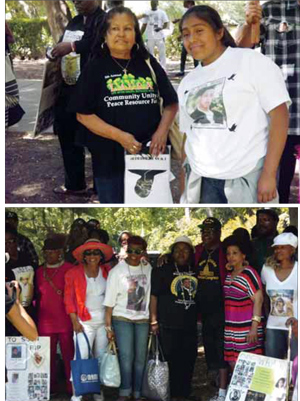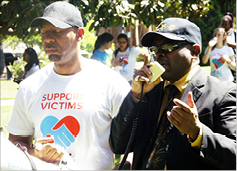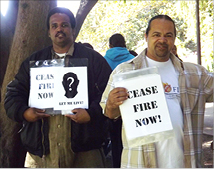By Charlene Muhammad CHARLENEM

SACRAMENTO – Hundreds gathered in front of the capitol April 23 to remember their murdered loved ones during National Crime Victims’ Rights Week. But, some whose family members died in police violence, foster care, and other killings rallied with this specific message: “Our children are victims, too!”
One rally, sponsored by the California Correctional Peace Officers Association (the prison guards’ union), but carried by Crime Victims United of California, called for a repeal of the state’s realignment plan. The plan shifts non-violent, non-serious, non-sexual offenders to local jails and supervision.
Another simultaneous rally on an adjacent capitol lawn, sponsored by Californians for Safety and Justice (a non-profit, crime victims advocacy organization), highlighted the depth of crime victims’ pain and their struggles to overcome such tragedies.
“We thought it would be important to elevate the voices of crime victims that’s not usually heard … Our loved ones are victims, too and we want healing for our community,” said Robert Rooks, organizing director for Californians for Safety and Justice.

He helped to organize chartered busses that carried more than 150 people on the “Bring the Healing” Bus Ride from Los Angeles and across the state for the event, which included a Healing Circle. The year old non-profit organization grew out of a desire to help the state safely implement realignment, he stated.
“What our folks came to say is we have a pathway to justice, too. And that our pathway to justice is not rooted in vengeance. Our pathway to justice is rooted in healing and prevention for ourselves and our community and that’s why we didn’t join in on that rally because we’ve heard those speeches before,” said Mr. Rooks.
Over the last 30 years, crime victims in California have played a major role in advocating for policies relating to death penalty sentencing, and they’ve done well to raise their voices and become opinion leaders on justice policy, Mr. Rooks noted.
However, they only represent a small percentage of California’s crime victims, he argued. “Categorically, they are often White – White men, White women – when over 90 percent of victims of crime in California are Black and Brown. So, we don’t see Black and Brown victims represented in Sacramento in the way that you see other victims,” Mr. Rooks told The Final Call.
“We have been going to the Victims’ March on the capitol for the last 10 years and we have been ignored. The real plight of victims have been ignored, particularly people of color,” said Mattie Scott, founder of Healing 4 Our Families and Our Nation, a non-profit advocacy group based in San Francisco.
Although an elaborate, ethnically diverse photo exhibit saturated the lawn of the Crime Victims United of California’s rally, Ms. Scott said there’s more to recognition than including their loved ones pictures in the event.
“We’ve been the number one victims in inner cities that suffer from gun violence, due to economic injustice that goes on daily in communities of color,” Ms. Scott said. Each year they’ve attended the March, hoping to grace the speakers’ podium to talk about their plight, but to no avail.
But, she keeps pushing in the name of her son and for other mothers whose children were murdered. Ms. Scott’s 20-year-old son, an activist who worked to improve the plight of Black males in his San Francisco community, was killed in 1996 while trying to stop a fight at a graduation party, she shared.

Her organization helps to support mothers like Maggie Agnew. Four of her six children have been murdered. Her five-month old daughter died of “unknown” causes while in foster care, according to the soft-spoken, wheel-chair bound woman. Two of her children were placed in foster care and four with their fathers, when she fell ill, she explained.
She insists, however, she was still very capable of caring for them when child protective services allegedly barged in her home to remove them. She turned to her community for help. But, by the time her children would be returned to her sister, her five month old daughter had been killed, Ms. Agnew stated. Her investigations led her to a dead end, she said.
Another son was killed in a drive by and the other while walking. And a third son was shot down by a so-called friend, as they were playing, she continued.
“I’m traumatized, for one thing…But, thank God I did have some support. I couldn’t even arrange their funerals, I was grieving so much,” Ms. Agnew said. Community activists and members of her church helped her to cope with her ordeal and to get her children recognized during the rally.
“I just broke down and started screaming,” stated Ms. Agnew on seeing them in the state photo exhibit this year. “It was so beautiful but I just couldn’t take it. I feel that if my sons and my daughter were here, I wouldn’t be in the condition I’m in now. They’d be helping their mama,” she lamented.

Paulette Brown’s son was shot 30 times trying to protect someone right outside her door, according to Ms. Scott. And Elsa Castillo’s son was killed in a drive-by, she said. The mothers attended the rally, hoping their voices and the voices of others suffering in high crime communities would be heard.
“They’re making their decisions around how they go home, how they leave their house, which way they drive to work, all because of crime. But, they’re not being heard in Sacramento,” stated Mr. Rooks. Inherently, the families want prevention, he added.
Cephus “Uncle Bobby” Johnson’s nephew, Oscar Grant, III.,was killed by former transit officer Johannes Mehserle in 2009. Though Mr. Mehserle was convicted of involuntary manslaughter and incarcerated, Mr. Grant’s photo was not in the main rally’s exhibit, according to Mr. Johnson.
“It appears that they pick and choose who they want…Most of the victims that were killed by police, all that I know of, weren’t posted there,” he stated. But he also admits he would never have filled out the required paperwork to have his nephew’s picture displayed. It’s a matter of public record, and, signing any releases would grant police authority to use it any way they desired, he explained.
“We have to remember 400 plus Black and Brown men die every year at the hands of the police. We have a major situation that’s not being addressed when it comes to gun violence by these heinous, rogue police officers that always claim ‘he was reaching for something.’ And we’re finding out over 50 percent never have a weapon when they’re killed but they call it a justifiable shooting,” Mr. Johnson stated.
Mr. Johnson attended the rallies to advocate for victims’ restitution and compensation for all families of crime victims. Many people don’t know the funds exist, he said.
Jon Myers, communications director for the California Victim Compensation and Government Claims Board, said it’s discomforting to hear anyone say they don’t have access to the funding, because the agency has even waged a social media campaign to help raise awareness.
“One of the hardest parts about my job is trying to ensure all the victims of California that this is there. No one knows that they’re going to be a victim so you don’t really pay attention to these types of services until you actually need it,” Mr. Myers stated.
One criteria for eligibility is victims may not be a part of the crimes committed, such as a gang member who got hurt, he explained.
In addition, if the victim had insurance or other similar means, their families do not get funding.
Offenders pay restitution directly to victims and the general restitution fund, fines ordered by a judge, is used to pay for medical bills, mental health treatments, funeral costs, and relocation costs.
Dorsey Nunn, of All of Us or None, a grassroots civil rights organization, which fights for ex-offenders and the incarcerated, believes identification is the first hurdle victims must overcome for funding, recognition, or otherwise.
“This is the first time that I’ve seen this many people of color being here and they don’t normally think that we can be victims,” he said.
The community’s rally provided a necessary counter-balance to that belief, because the state’s holding up one idea of a victim, and that’s supported by the prison guards’ union, he argued.
“If you ever really look at it, the way they define victims, Oscar really wasn’t a victim. The rally we had here defines victims that includes victims of police brutality … people that have been convicted of crimes. In the event I should happen to get shot, beat down as a result of my conviction history, I may not even be eligible for anything they offer anybody else … In fact, we go to the bottom of the list, ” Mr. Dunn told The Final Call.
Mary Rigmaden stoically held a picture of her son, Manuel Roybal, and his two-month-old baby girl. He was killed in Stockton’s 36th homicide last year, according to his mother.
She attended the rally for the first time to try to gain support. So far, she’s been helped by Carey Downs, her brother-in-law, and other family members.
Mr. Downs’ own 16-year-old son, James Rivera, Jr., was shot and killed July 22, 2010 by two Stockton police officers and one San Joaquin Sheriff deputy, he told The Final Call.
The case drew heavy media and public attention because of allegations of excessive force. Police used a pit maneuver to push his son into a garage and opened fire, according to Mr. Downs. Eighteen of 48 rounds penetrated his son’s body and he was killed in seconds, Mr. Downs stated.
“We’re fighting against the system right now. And you know, they’ve got a lot of power, but if you don’t get answers, it leaves you in a state where, who am I going to get these answers from,” Mr. Downs said.
The case is in limbo as the family’s still demanding their son’s personal property, dash cam video footage, police reports, and answers to why they killed our son, he stated.
Reverend Benny “Taco” Owens of the Southern California Cease Fire Committee and founder of the Detours Mentoring Group, traveled from Los Angeles.
He came to represent victims in Black and Brown communities and advocate for support for their loved ones, families, and friends impacted by violence.
“It’s been presumed that if you’re a victim, that basically, you died at the hands of someone who was committing a crime and you probably wasn’t a person of color. Sometimes in our communities, when people get killed, whether it’s a drive-by or some criminal act of violence, we don’t get the recognition as it being an act of violence, or us being a victim as a result of violence,” Rev. Owens stated.
According to Harriet Salarno, chair of Crime Victims United of California, 2013 marks the 24th year the organization has put on their rally to honor all victims of violent crime.
She refuted claims that victims of certain crimes are rejected from their rally. “We’re very supportive of all that. A murder is a murder,” she told The Final Call.
Ms. Salarno acknowledged there are bad apples in every organization, law enforcement, government, and foster care, but her organization supports law enforcement for its good work, she said.












